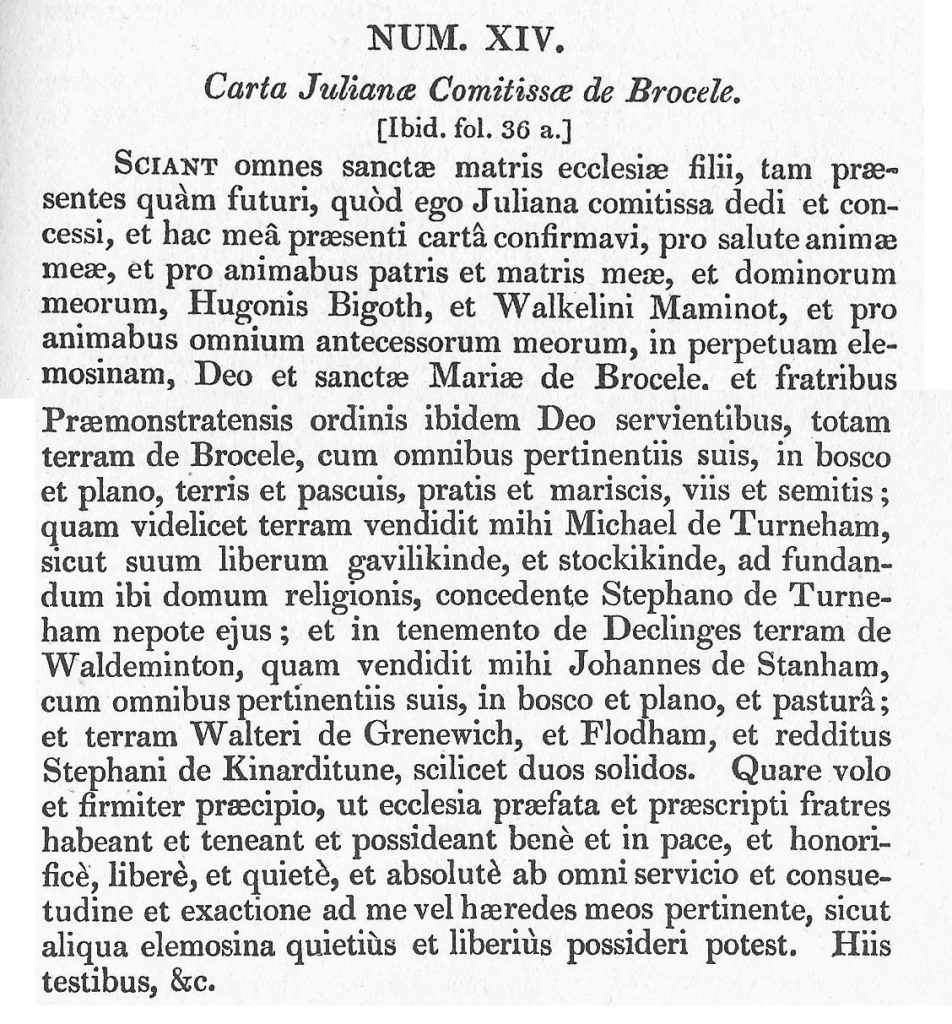ORIGINS & FOUNDATION
There is no recorded reason why the canons of Sulby (in Northamptonshire) should choose to settle at Brockley in Kent. Colvin suggests the connection may be that Aubrey de Vere II, the father of their founder (countess Juliana), had held land in Northants and Juliana will have made religious contacts there.
Juliana’s (second) husband, Walkelin Maminot, had enfeoffed Brockley to Michael Thornham, but on Walkelin’s death (c.1156) Juliana bought back the land from Michael with the intention of founding an abbey there and she acted together with Michael Thornham, who is also be considered to be a founder of Brockley; he gave gifts of land in Kent and Sussex to the canons of Brockley.
Colvin (p.109) notes: ‘A much damaged charter in the Bodleian Library records that, at the petition of the Countess Juliana and Michael Thornham her seneschal, Walter, Bishop of Rochester, went to the place called Brockley (in north-west Kent, between Deptford and Lewisham), where, in his presence, they gave in free alms to the canons of Welford [Sulby] the place of Brockley itself, together with 5 ploughlands and a rent of 12 marks for the support of those canons whom the bishop then admitted to the regular life there, and of those who were in future to be admitted.’
There is a confirmatory charter recorded in Dugdale – NUM. XIV Charter of the Countess Juliana of Brockley (see below) – Translation is HERE

HISTORY
We know virtually nothing of the short history of Brockley Abbey. Its foundation was probably around 1180, and by 1207, the Brockley canons had removed to Bayham.
It is not recorded why the canons found Brockley to be an unsuitable site but in a charter of Michael of Thornham, listing all his gifts to the canons of Brockley, he gave the canons permission to transfer their ‘abbey’ elsewhere if they so wished. There were, without doubt, already links between the canons of Otham and of Brockley and there was a very clear reason and desire for the relocation of the Otham canons . . . perhaps the pre-existing links coupled with the improved chance to survive and prosper if they merged their convents, prompted the move? Around 1208, Michael’s nephew, Robert of Thornham gave the canons all his lands of Begham (now Bayham) in order to build an abbey there,
The combination of these two communities to form Bayham may well have presented some problems around the issue of governance; Brockley was a daughter of Sulby and Otham a daughter of (probably) Durford. Thus, the new community at Bayham Abbey was directly governed from Prémontré (one of only two such houses in England) perhaps in a bid to prevent administrative strife between the mother houses.
The lands at Brockley remained the property of Bayham until dissolution and it is quite possible that, like Otham, Brockley became a grange of Bayham.
DISSOLUTION
Bayham Abbey was amongst the twenty-nine houses chosen by Cardinal Wolsey for dissolution in 1526, to fund his new schools and colleges in Ipswich and Oxford.
In 1529 following Wolsey’s attainder the manor of Brockley was seized by the Crown. It went on to pass through many hands (see post-dissolution section).
Brockley was a hamlet amidst farmland until the mid-nineteenth century when the area was taken over for housing. Manor Farm was reputed to be the site of Brockley abbey and medieval building remains, possibly belonging to the abbey refectory, were located there in the mid-nineteenth century.
Thank you for this information. I have just read an extremely interesting book entitled “History of Deptford” 1st published in 1884 and republished 2015 (my copy)by Famloc.
In the section called ” The Manor of Brockley” it states :-
” Michael de Turnham afterwards sold his land of Brocele as his free GRAVILIKINDE and STOCKINIKINDE to the countess Juliana, wife of Wakelin de Maminot….etc ”
Would you kindly enlighten me as to the meaning of these two words I have written in capitals.